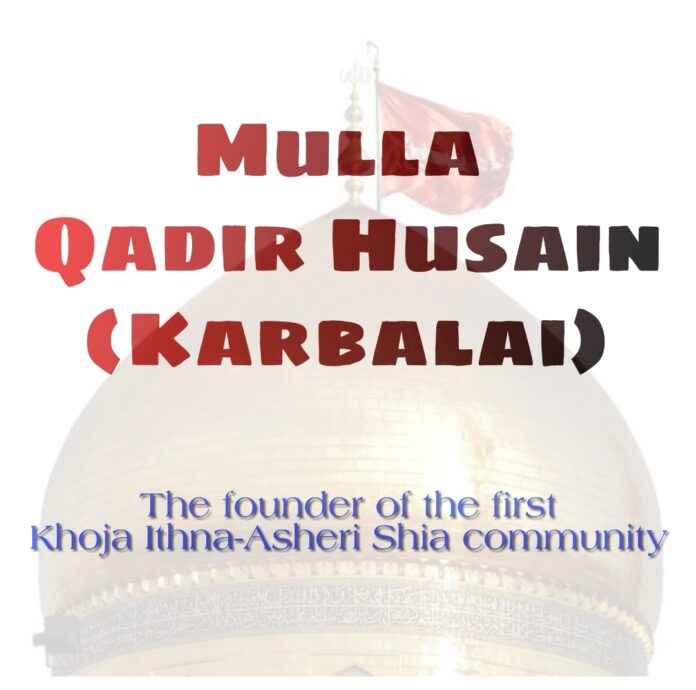Following our recent story on early Khoja martyrs we look now at the case of a preacher who would himself have been a martyr … but instead turned his would-be murderer into his student.
This is the story of Mulla Qadir Husain, who guided our community at its very beginning and originated what it is now.
Turning point in the history of our faith
Mulla Qadir became the founder of the first Khoja Ithna-Asheri Shia community in the Indian city of Bombay and overcame countless obstacles to do so.
Born Madras in 1842, his passion for Islamic studies from a young age took him to Karbala in Iraq, where he was a student of Ayatullah Zaynul Abideen Mazandarani.
In 1873 Ayatullah Mazandarani sent him to Bombay as an alim at the request of the philanthropist Haji Devjibhai Jamal.
This was a turning point in the history of our faith.
Threats to his life
Mulla Qadir preached and guided many Ismaili Shias into the Ithna Asheri (Twelver) faith. He conducted Majalis at his house along with Jamaat Namaz.
But splitting from the mainstream Khoja Ismaili community brought him many hardships: he was forced to move out of his rented apartment, not allowed to rent another apartment in Khoja Mohalla, and even faced threats to his life.
The students who supported him – including his star students the philanthropist Haji Devjibhai Jamal, Haji Gulamali Haji Ismail (Haji Naji), Noor Mohammed Meghji and Khalfan Ratansi Aladin Gulam Husain (Ain-Ghain) – were also thrown out of the Jamatkhana and were socially boycotted.
Yet it was these loyal students who spread the Ithna Asheri faith to Kutch and Kathiawad in Gujarat as well as to Zanzibar in East Africa.
Increasing danger
As tensions rose, Mulla Qadir felt increasing danger. He was targeted by propaganda and false allegations that led some new students to boycott his teaching.
Ayatullah Mazandarani prayed for his safety and encouraged him to continue his tableegh work without fearing anyone except Allah (swt). He sent frequent letters addressed to the community at large reminding them that Mulla Qadir was their spiritual leader and that they had to take care of him, listen to him and assist him.
One of his letters addressing Mulla Qadir read: “Your speech is my speech and your respect is my respect”.
Assassination plot
But some remained implacably opposed to his ideas. The head of the mainstream Khoja community vowed to rid Bombay of this preacher he regarded as a troublesome challenge. He ordered a man named Killu Khatau to kill Mulla Qadir by poisoning him.
This instruction gave Killu Khatau pause for thought, however. He asked himself: “If the chief is really an authority by Allah, why does he want to get Mulla killed instead of using divine powers to silence him?”
Killu Khatau refused to carry out his deadly task … and instead he started learning the true religion. He became a regular student of Mulla Qadir and began tableegh activities openly in Khoja Mohalla.
As a result of Mulla Qadir’s simplicity and authenticity, his would-be murderer turned into his student and served the religion!
Mulla Qadir’s achievements
In 1893 a Khoja by the name of Ibrahim Hashembhai purchased a house for Mulla Qadir in Khoja Mohalla. He made this house Waqf for the Ithna Asheri Khoja to carry out Madressah, Majalis and Salaah activities. This house was known as the Ithna Asheri Madressah and is now renowned as Madressah e Mulla Qadir Husain Sahib.
Mulla Qadir published the first edition of Chirag e Hidayat, which served as a guide book to Islamic laws. It spread far and wide across India and to other places where there were Gujarati- and Urdu-speaking Shias, including Zanzibar, China, Muscat, Mauritius and the UK.
He founded two mosques in India: Masjid e Haidery in Bhiwandi in 1874 and Masjid e Husaini in Malegaon.
Mulla Qadir returned in 1901 to Karbala, where he passed away in 1902. Although not a Khoja himself, as the Ithna Asheri community’s first preacher he has an unrivaled place in our history.













